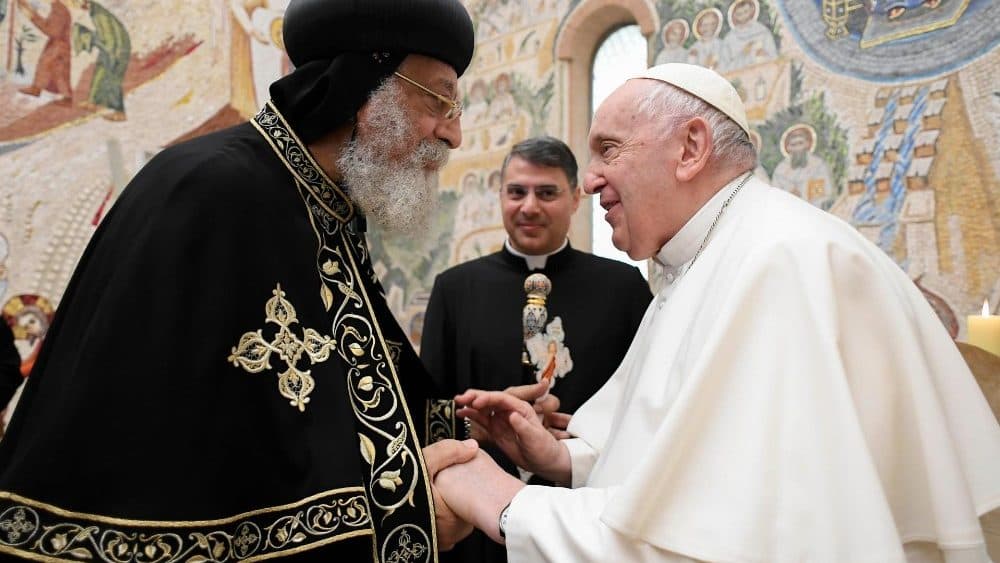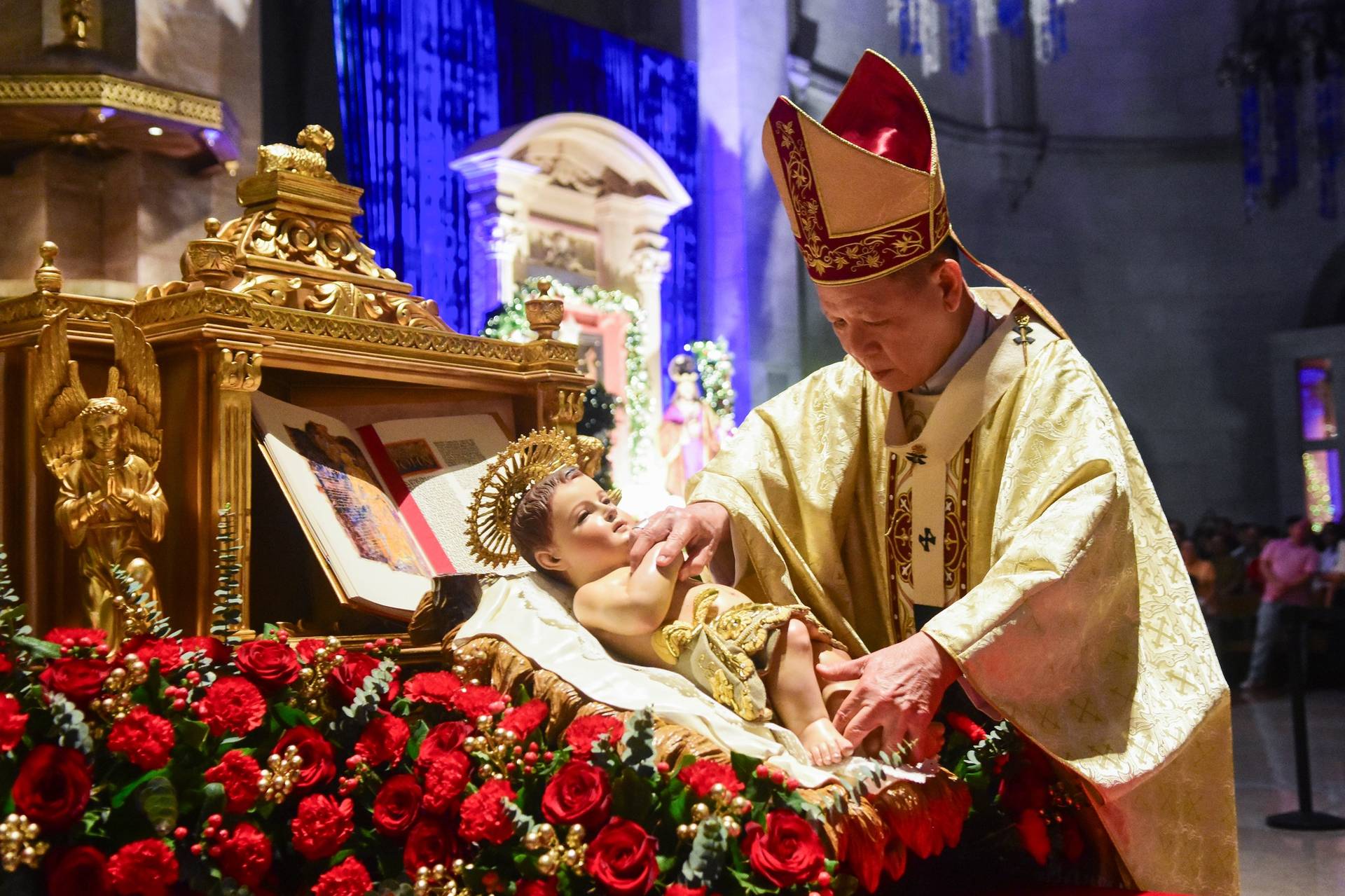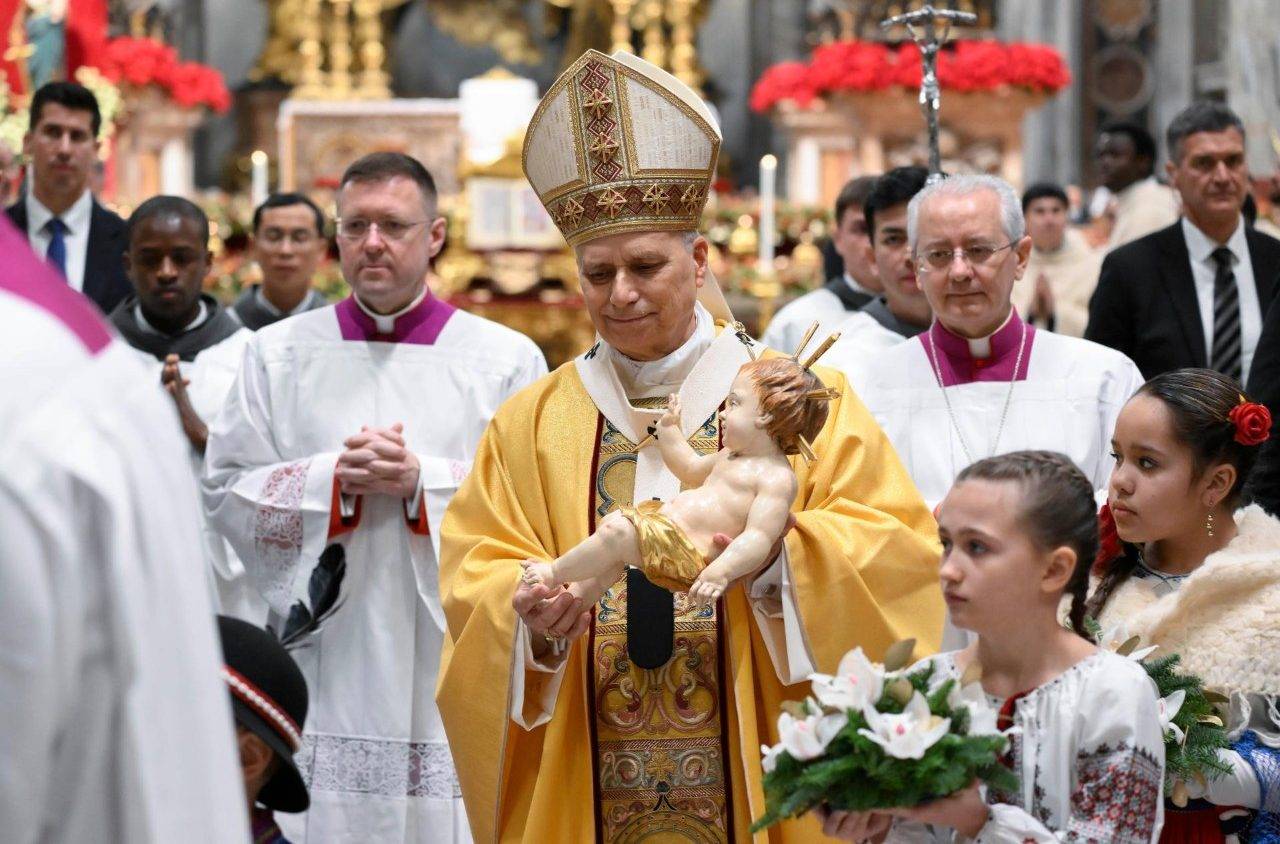ROME – In a highly unusual move, Pope Francis formally inserted 21 Coptic Orthodox martyrs killed by ISIS into the church’s formal martyrology, marking one of the rare occasions in which non-Catholics have been approved for veneration in the Catholic Church.
Standing beside his Coptic Orthodox counterpart, Pope Tawadros II, Francis on Thursday highlighted the various points of progress in the dialogue between their two churches and thanked Tawadros for the gift of relics of the 21 Coptic Orthodox martyrs.
“On this journey of friendship we are also accompanied by martyrs, who testify that, ‘greater love has no one than this: to lay down one’s life for one’s friends,’” he said, saying, “I have no words to express my gratitude for the precious gift of the relic of the Coptic martyrs killed in Libya on Feb. 15, 2015.”
Perhaps one of the Islamic State’s most notorious and gruesome killings, the 21 Christian construction workers were taken captive and paraded onto a beach in Libya by ISIS militants, wearing orange prison jumpsuits and handcuffs.
In a horrifying video ISIS later published online, the militants beheaded each of the prisoners, 20 of whom were Coptic Orthodox and one of whom was a Christian from Ghana. The men prayed to Jesus as they were being executed.
The bodies of the men were finally recovered in October 2017, after one of the perpetrators was caught by Libyan authorities and disclosed the location of the remains, which were repatriated to Egypt in May of that year. Upon arrival, the plane carrying the remains was met by Tawadros, who resides in Egypt, where the global headquarters of the Coptic Orthodox church is located.
Pope Francis in his speech Thursday said these 21 men “were baptized not only in water and the Spirit, but also in blood, a blood that is a seed of unity for all followers of Christ.”
He then announced that, with the consent of Tawadros, the 21 men “will be included in the Roman Matryrology as a sign of the spiritual communion that unites our two churches.”
The Martyrology of the Catholic Church is considered a liturgical book and is used for the praying of the daily office, meaning the Copts can now be recalled in official Catholic prayers. Officials said the Coptic martyrs likely will be inserted among the saints recalled on Feb. 15, the same day the Coptic church commemorates them.
Though rare, such a move is not entirely unprecedented.
In 2001, certain Orthodox saints from after the historical separation between East and West were included in the Roman Martyrology. This is apparently the first time, however, that the inclusion was done with the explicit approval of the leader of a non-Catholic confession, and also the first time that the martyrs involved are contemporary.
Thursday’s gesture reflects a long ecumenical development.
In his 1995 encyclical Ut Unum Sint, Pope Saint John Paul II called for a common martyrology, and in 2001 decided to introduce a handful of Orthodox and Eastern Orthodox saints into the Catholic Martyrology.
Similarly, Pope Francis, though not calling for it directly, has repeatedly indicated his desire for a common Christian martyrology, often saying there is an “ecumenism of blood” among those killed in violent anti-Christian persecution, regardless of what rite or church they belong to.
Tawadros in his own speech Thursday said the saints “are one of the main pillars of our churches,” and he called the 21 Copts killed by ISIS men “who have kept the faith and bore witness to Christ, who did not lose heart in the face of torture, and who have passed onto us a living example in martyrdom.”
Noting that Feb. 15, the day on which the 21 Copts were killed, is now observed by Coptic Orthodox as a feast day for martyrs in the modern era, he said the gift of the relics is so that they “may be remembered in the martyrology of all the churches of the world.”
They are “a model and contemporary example for the whole world, testifying that ours is not a historical Christianity of the past, but one of yesterday, today, and forever,” he said.
Based in Egypt, the Coptic Orthodox Church, also known as the Coptic Orthodox Patriarchate of Alexandria, is an Orthodox Christian church which traces its founding to the Apostle Mark, hailed as one of the four Evangelists in Catholicism and who is buried in St. Mark’s cathedral in Venice.
Coptic Orthodox constitute not only the largest population of Christians in Egypt, but in the Middle East as a whole.
RELATED: Two popes, Roman and Coptic, meet to bolster Middle Eastern Christianity
Tawadros II is currently in Rome to celebrate the 50th anniversary of the first-ever meeting between the Catholic and Coptic Orthodox popes, which took place in May 1973 when Pope Saint Paul VI welcomed Coptic Orthodox Pope Shenouda III to the Vatican.
On that occasion, the two signed a joint declaration outlining their shared Christological beliefs, specifically in Christ’s identity as fully God and fully man.
Prior to the meeting, Paul VI in 1968 had made a point of returning several of St. Mark’s relics to Egypt’s Orthodox Copts, having received a request to do so by Patriarch Cyril VI for the commemoration of the 1900th anniversary of St. Mark’s martyrdom.
The relics were reportedly stolen and brought to Venice in 828. The fragments returned by Paul VI were placed in an altar built for the occasion and are still present there to this day.
In the joint declaration, Paul VI and Shenouda III also pledged to overcome differences and established a joint working commission to study theology, history, and modes of cooperation.
A second meeting between a pope and Coptic Patriarch took place when Shenouda III met with Pope John Paul II in Cairo in February 2000, during the Polish Pope’s pilgrimage for the Great Jubilee held that year.
The most recent meeting, forty years after the 1973 meeting, was held May 10, 2013, when the newly-elected Pope Francis met with the also newly-elected Pope Tawadros II in Rome, making their meeting this week the second encounter between the two.
Francis traveled to Cairo in 2017, where he met with the country’s top Muslim authority, the Grand Imam of Al-Azhar, and paid a courtesy visit to Tawadros.
During his visit to Rome this week, Tawadros attended Pope Francis’s Wednesday general audience, making it a rare occasion when two popes led the event together, each of whom offered speeches.
After the formal meeting between the two Thursday morning, Francis and Tawadros shared a moment of prayer together in the Redemptoris Mater chapel of the Vatican’s apostolic palace. Tawadros was expected to celebrate a liturgy for Coptic Orthodox living in Rome later that evening at the papal basilica of St. John Lateran.
In his speech Thursday morning, Pope Francis stressed the importance of “always looking forward” when it comes to ecumenical dialogue, while also remembering the milestones already achieved.
He noted that since 2013, at the request of Tawadros, May 10 is observed annually as the “Day of Friendship between Copts and Catholics.”
“The bonds of friendship between our churches are rooted in the friendship of Jesus Christ himself with all of his disciples whom he himself calls ‘friends,’ and whom he accompanies on their path, as he did with the pilgrims of Emmaus,” he said.
Francis closed voicing hope that the prayer of the Coptic martyrs would “continue to make our churches grow in friendship, until the blessed day when we will be able to celebrate together at the same altar and communicate to the same body and blood of the savior, ‘so that the world may believe.’”
Likewise, Tawadros in his own speech said it was an “immense joy” to be at the Vatican, and that he sees the world as “a great circle centered on God.”
“Each of us is in a point of this circle and every time we approach God, or rather the center of the circle, we find ourselves approaching each other, we understand each other for the closeness to the divine light and our love grows day by day through our closeness to God,” he said.
This path is a long one, he said, and stressed the responsibility of Christians to become like God, “and offer our unconditional love to each other and to the whole world.”
He also pointed to the various steps that have been taken in Catholic-Coptic Orthodox dialogue, saying, “we are walking the path of love, keeping our gaze fixed on Jesus.”
“Dialogue is a long but sure journey, protected by the two sides of love: that of Christ’s love for us and that of mutual love. So no matter what happens to us, as in the challenges we face, we have love protecting us so that we can continue our mission and progress in mutual understanding,” he said.
Tawadros stressed the importance of prayer, and closed by praying “for God’s church on earth, that he may establish it forever, so that it may always give heavenly praise, and keep it with his care that neither neglects nor sleeps, and bless us all forever.”
Follow Elise Ann Allen on Twitter: @eliseannallen
















